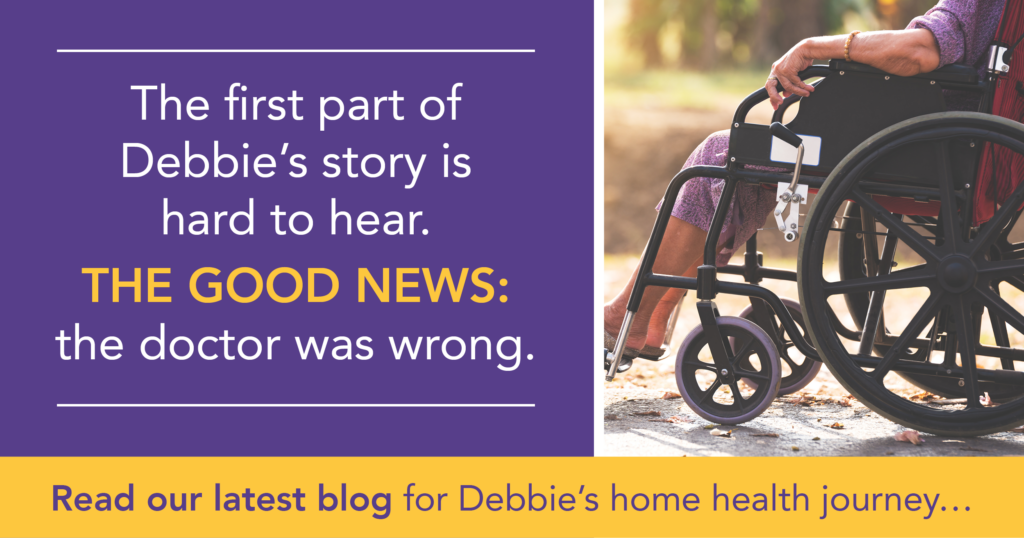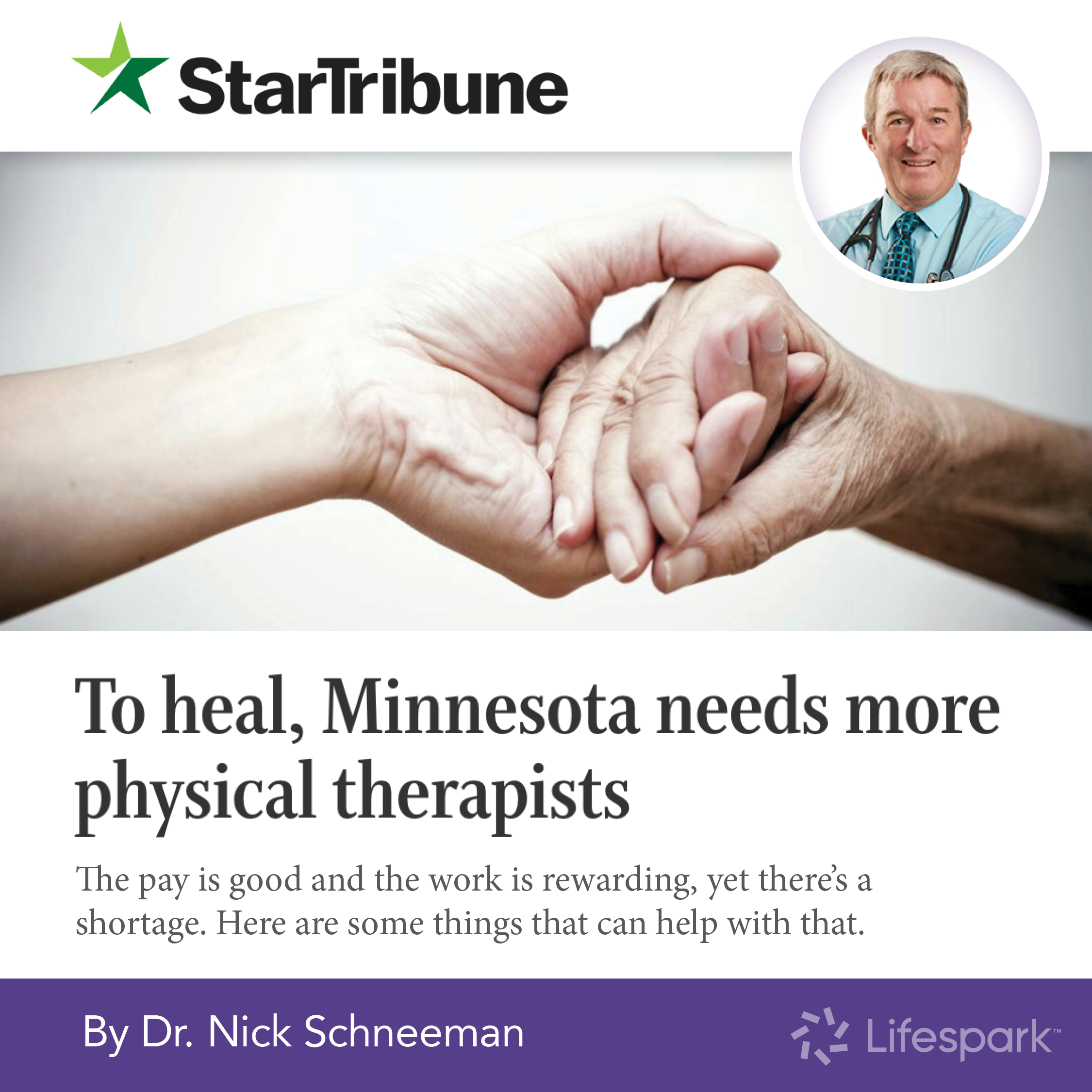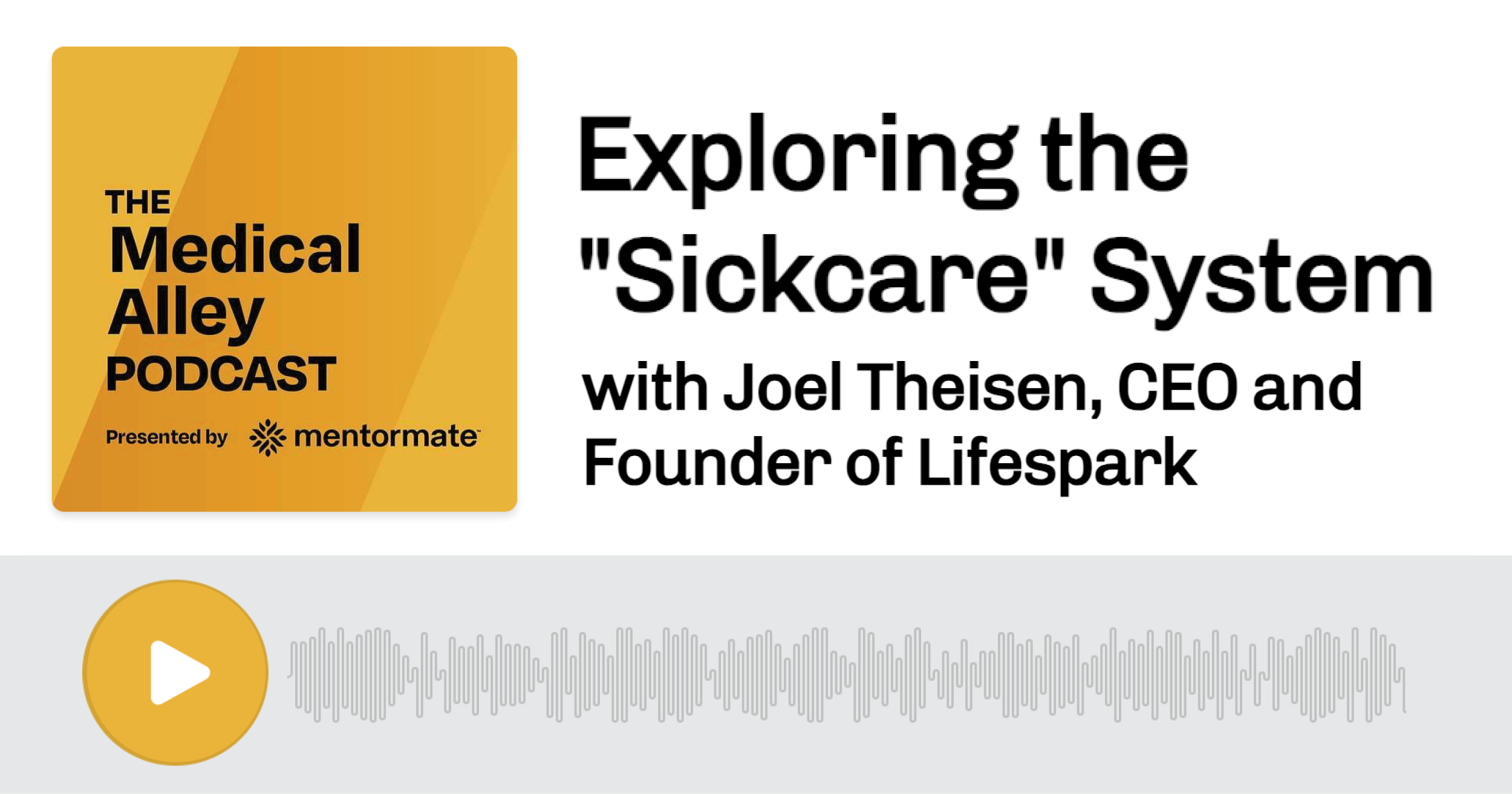
“At 3:00 in the morning, I got up to use the bathroom. I had the worst side-ache of my life. I thought it was my appendix. Or maybe I was having a stroke,” said Debbie, a Lifespark Home Health client.
One ambulance ride later, Debbie landed in the hospital where she would spend most of the next four months. Until that time, she’d been leading an active life, surrounding herself with multi-generations of family, spending time at their cabin up north, and riding with her 4-wheeling club.
Diagnosis, surgery, and more surgery
Debbie was told that two bulging discs in her upper spine had injured her spinal cord. Rushed into emergency surgery, she received eight screws and three bars—and two nicks to her spinal cord that would lead to another emergency surgery the next day. Eight more screws. Two more bars. Before Debbie was discharged from the hospital for the final time, she’d endured 10 back surgeries, several infections, and a resulting overdose of antibiotics.
One of her darkest memories was the day she received the prognosis from her surgeon.
“He sat on the edge of my bed and took my hand,” said Debbie. “He told me, ‘I’m sorry sweetie. (He always called me sweetie.) I don’t think you’re ever going to walk again.’”
This first part of Debbie’s story is hard to hear. The good news: the doctor was wrong.
Her Lifespark team was ready
Debbie wanted to go home. Her husband, George, wanted that too. So, he remodeled their house to make it accessible, bought a special van, and readied himself to become her primary caregiver. Other devoted family members stepped up to help. And Debbie’s Lifespark Home Health team rounded out her integrated support system.
They all had a big job ahead. Debbie’s physical condition would require constant effort.
- She was unable to move the right side of her body
- She needed a Hoyer (sling) lift to move from bed to wheelchair
- A medical pump device was helping to heal three separate surgical wounds
- A catheter and various procedures were needed to facilitate body functions
- She was basically bedbound
There were bleak times at first. When Debbie started with Lifespark Home Health, she was still on the roller coaster of health care crises. In and out of the hospital. The team would address one problem, and another would pop up. The whole time, George was her rock. He was learning how to care for Debbie’s complex medical needs, and, at the same time, embracing his role as her head cheerleader. Still, it’s heartbreaking to watch someone you love suffer.
“Early on, she had PTSD,” says George. “She was paranoid, right in her own home. I crawled into her hospital bed and held onto her to help her stop crying. But she cried through the night.”
Since Debbie’s initial injury, George’s body, too, has reacted to the physical and emotional stress. He’s lost more than 20 pounds, his hair has turned grey and fallen out, and then he fell over his shopping cart at Target, thinking he was having a heart attack. It turned out to be pure exhaustion. But through it all, he made it clear to anyone who asked: no, she was not going to a nursing home.
“Lifespark taught me how to do all this stuff,” he says. How to clean her wounds, give antibiotics, and do saline flushes. They showed me how to keep her clean—and she never got an infection.”
Most of George’s care instructions came from the primary members of Debbie’s Lifespark team: Lindsey Kraft, RN, Liz Fusselman, PT, and Rhonda Adelman, OT. Or as Debbie endearingly calls them, The Girls.
Once the constant trips to the hospital stopped and Debbie returned home for good, everyone focused their energy on healing her injuries and increasing her strength. They began to make lightning-fast progress.
Lindsey describes the wonder felt by the whole team: “It was so special to see her make incredible gains in EVERY discipline at a consistent pace. The better she got because of physical therapy, the easier occupational therapy was for her. The stronger and more mobile she got with therapies, the better her wounds started to look because she could move herself around again.”
One by one, Debbie’s Lifesparkers were able to free her from all lines, drains, and electronic devices—even the catheter that the doctors had thought would be permanent. But none of those medical improvements would have been possible without the most important member of their team: Debbie. She was the fuel behind her own full-speed-ahead progress. All The Girls agree passionately on that.
Rhonda, OT – “Debbie’s drive was the main reason things changed. She was just so motivated, even though, at times, she was paralyzed with fear—and sleeping, at max, two hours because she was in so much pain.”
Liz, PT – “One word. Amazing. Debbie’s a remarkable human being. You walk in, and she’s got that light that makes everybody feel better about themselves. A really positive outlook.”
Lindsey, RN – “She wanted to work really hard to get better, which made us want to work hard. The harder she worked, the harder we worked.
And when you ask Debbie how she kept motivated when life was so painful and her future so uncertain, her answer is immediate: “It was my family. I really love my kids and my family. I’m not going to be stuck in this house. If I don’t walk pretty, that’s okay. I just want to get back up north with my kids.”
Debbie on the move
When Debbie turned to Lifespark for her home health needs, she thought she’d be bedbound forever. The main goal in her rehab was to enable her to stand and pivot so she could get herself into a wheelchair without needing the assistance of two other people or a mechanical lift. Even that goal took a lot of courage, time, and determination on Debbie’s part. It’s a very scary proposition to try to stand and turn when only half of your body does what you ask it to. And when your spine is already compromised, what happens if you fall?
But Debbie was up for the challenge, so they began working on it. Her team took every precaution to keep her safe, including the use of a gait belt (a strap that goes around Debbie’s waist for the caregivers to grasp and hold her steady). And Debbie eventually mastered the maneuver.
“They made me feel confident,” says Debbie. “They said, ‘You can stand and pivot.’ They’d put that belt around me and pull on it. I should have a skinny waist by now, but I don’t. I was afraid—but now it’s like nothing. I credit The Girls being here. They were my inspiration.”
But Debbie wanted to walk!
After two months of nursing care, PT, and OT, the team realized that Debbie was starting to get some sensation back in her right leg.
A particularly memorable day stands out for Rhonda, Debbie’s OT: “We started to pivot from the bed to the commode chair—and I could see she was moving that right foot! So, I asked her if she wanted to try a couple steps. I told her, ‘You have me here, George, your grandson, and your walker. We can do this.’ She ended up walking 10 feet with me hanging onto her and George pushing her wheelchair behind, just in case.”
When Debbie took those first steps, everybody was in tears. Her grandson was shooting video of the event and shared it with the whole family.
Debbie. Was. Walking.
George
Of course, those initial steps were just the first of miles to go. For two more months, Debbie’s Lifespark team would be on hand, helping her build strength and solve problems as they arose.
“I worked really hard,” says Debbie. “But I’m not a perfect person. Some nights I’d cry myself to sleep, but the next day I’d pick myself up.”
And once she was up again, George would be there to help get her moving. Lifespark couldn’t be at their house around the clock, so the responsibility fell to the Debbie-George tag team to carry through on the exercises and instructions they’d been given.
As Lindsey puts it, “George and Debbie listened to every word we said to them and always asked great questions. They demonstrated that they valued and respected what we had to say as clinicians. And they took getting better very seriously, while still laughing along the way. So, so many laughs were had at that house!”
Case in point, George wrote a poignant and hilarious book about the first part of their home health experience entitled, Debbie’s Whispering Pines Wellness Center.
“I’m really lucky to have been married to a wonderful husband for 48 years,” says Debbie. “He’s the nicest guy I’ve ever met. But The Girls would tell him what to do when they were gone, and he was the task master. There weren’t many days off watching TV and eating bonbons.”
George doesn’t quite remember it that way. In fact, during Debbie’s long rehab period, he’d jokingly tell her that, “If I have to watch one more Hallmark movie, you’re going to see me on the news.”
So… how’s Debbie doing now?
Debbie was under Lifespark’s care for a total of four months. During that time, her mobility improved significantly. With George by her side, and wearing her belt, she can now stand, get dressed, do her hair, and walk from one room to another. She says her only complaint about Lifespark is that they made it possible for her to do the dishes—something she’d escaped for the past eight months. But she’s not 100% yet. She still spends most of her day in the “fancy-pantsy” power wheelchair that Lifespark arranged for her. (Side Note: For the chair’s pattern design, she could choose between daisy or camouflage. Guess which one Debbie-the-warrior opted for.)
Recently discharged by Lifespark, Debbie was referred to the Courage Kenny Institute for outpatient rehab. Because of nerve damage, her right leg still wants to buckle under her weight, so they’ll help her build more muscle. As usual, Debbie’s outlook is positive: “I’m beating this! At first, I could barely sit on the edge of my bed. By the time everyone was gone, I was walking laps around my bed. I might not ever be skipping or wearing stilettos, but I’m good with my old tennis shoes.”
A happy ending
As her Lifespark team tells it, Debbie’s experience was a perfect example of how home health care can make a difference in someone’s life. Lindsey describes the reason for their success like this: “We weren’t without setbacks. But it was overcoming the obstacles as a true team, with Debbie as team Captain, that made it work in the end. And we’re all sooo happy for her!”
To learn more visit Lifespark services, visit https://lifespark.com





